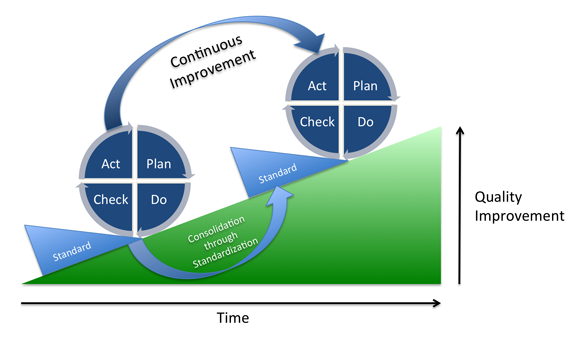Quick Guide to ITAM CSI

CSI , no not Crime Scene Investigation but CONTINUAL SERVICE IMPROVEMENT!
This article provides a quick introduction to ITAM CSI and the value it brings in maintaining momentum in your ITAM practice.
We cover CSI in module 9: REPORTING, of the ITAM Review 12 Box Training Course. It is an essential concept to understand when developing reporting that people actually want to read and maintaining momentum and engagement.
What is CSI?
No, not blood on the carpet and DNA samples in Miami… CSI in the context of this article stands for Continual or Continuous Service Improvement. It is a concept borrowed from ITIL and the Service Management arena that encourages a spirit of continual improvement.
“Continual service improvement, defined in the ITIL continual service improvement volume, aims to align and realign IT services to changing business needs by identifying and implementing improvements to the IT services that support the business processes.” ~ Wikipedia
Why ITAM CSI?
CSI is an important concept to understand in a fast moving and complex arena like IT. The old adage says that a plane flying between two cities is off-course 99% of the time, but is constantly correcting itself. The same approach can be considered for your ITAM practice, you might have the most impressive and bulletproof business plan at kick-off, but it needs to evolve over time as your business and technology changes.
Why do we need a CSI approach for ITAM?
- ITAM takes time – A world class ITAM practice is not built over night and may take many years to perfect. In the meantime the goal posts are likely to change, the ITAM leader has to have the acuity to change course mid-way through the process, potentially many times over.
- Businesses constantly evolve – Goals and business priorities change. What was mission critical in January becomes old news in February. Businesses get acquired, divested and they expand and contract.
- ITAM should be responsive – Modern ITAM should be iterative and flexible. It should be modular and listen to feedback so it can adjust course accordingly. See this video from Tony Crawley on ‘Talking ITAM to the CIO‘, which covers an agile approach.
- Communication needs to be relevant – Finally, ITAM communications should be relevant and current to be successful. An ITAM program that spouts outdated direction will be seen as irrelevant and out of touch.
ITAM CSI implementation
OK, so much for the theory – how do we go about doing it?
The Deming cycle is commonly cited as a methodology to consider for CSI. In layman’s terms: Build a feedback loop for how you are doing and listen to it.
The Deming cycle suggests four major steps:
- PLAN – Plan what improvement is required in your ITAM practice to improve efficiency, effectiveness or financial impact
- DO – Execute the plan as a project with a specific goal
- CHECK – Verify success via measurable metrics or perhaps an audit to check accuracy
- ACT – Act upon any findings or lessons learnt
- REPEAT – Constantly repeat this cycle looking for new areas of improvement and alignment with business priorities
The goal is to steadily improve your ITAM practice over time in iterative steps, increasingly quality, accuracy and impact of your efforts as per the diagram below. We cover how to actually do this in practice using real life examples during module 9, but an example might be audit responsiveness, gradually improving by listening to feedback.

ITAM CSI: A gradual improvement to ITAM practice and processes
Learn more about CSI, reporting, keeping stakeholders engaged and keeping your ITAM practice relevant in module 9 of the 12 box training course.
- Image credit – CSI
- Image credit – PDSA
Related articles:
Use automated workflows to govern IT at the speed of business
Process of the Month – Software Request Process
Podcast Episode 29: Women in the Field of ITAM
CAPEX v OPEX: A tale of two budgets
Mitigate risk and vulnerabilities in your organization
Hard drive disposal best practice - Community survey results
- Tags: Business Relevance · Continual Service Improvement · CSI · Deming · ITAM CSI · PDCA
About Martin Thompson
Martin is also the founder of ITAM Forum, a not-for-profit trade body for the ITAM industry created to raise the profile of the profession and bring an organisational certification to market. On a voluntary basis Martin is a contributor to ISO WG21 which develops the ITAM International Standard ISO/IEC 19770.
He is also the author of the book "Practical ITAM - The essential guide for IT Asset Managers", a book that describes how to get started and make a difference in the field of IT Asset Management. In addition, Martin developed the PITAM training course and certification.
Prior to founding the ITAM Review in 2008 Martin worked for Centennial Software (Ivanti), Silicon Graphics, CA Technologies and Computer 2000 (Tech Data).
When not working, Martin likes to Ski, Hike, Motorbike and spend time with his young family.
Connect with Martin on LinkedIn.
